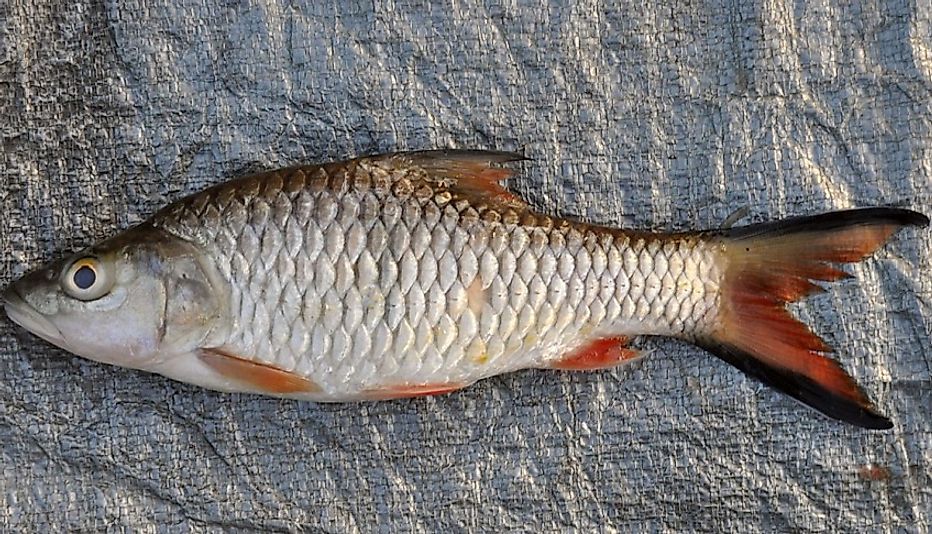Native Fish Of Malaysia

Malaysia is home to a great biodiversity of wildlife, including a varied collection of fish. From the Malay peninsula to its islands and out to sea, Malaysia is teeming with freshwater and marine fish life. The Sulu Sea, for instance, is home to 1,200 species of fish. The freshwater fishes, however, dominate the Malay lakes, rivers, and stream. This wide range of fishes favors the Malay fishing industry, regardless of whether it is for food or trade.
Whale Shark (Rhincodon typus)
This species has wide mouths of up to 1.5 meter, with 300 to 500 teeth and ten filter pads. Their heads are large and flat with a pair of small eyes. They have a gray body, white belly with yellow spots that are unique to each individual. They have five pairs of gills, a pair of dorsal and pectoral fins and ridges on their sides. They feed on planktons, nektonic, and crab larvae. They occur globally in the oceans around the equator and inhabit warm waters at the coastal and ocean areas. The whale sharks are docile and slow swimmers and do not pose any serious risk to divers. They reach sexual maturity at 30 years and may live up to 100 years. The female shark is ovoviviparous where it retains the eggs in its body until they hatch and gives birth to live young ones over a period. They are majorly solitary and groups of close to 100 individuals only appear once in a while especially when they are feeding. The International Union for the Conservation of Nature (IUCN) classifies the species as vulnerable on their Red List of Threatened Species. Their primary threat is irresponsible fishing practices. They have a slow reproduction rate, and they live long which also put their population at risk of exploitation.
Hampala Barb (Hampala macrolepidota)
The Malays refer to this fish as the Sebaru or Jungle Perch. They have no teeth but instead, have powerful jaws with sharp gill rakers. Their mouths are thick and leathery, used for destroying premium treble and hooks. Under their dorsal fins are vertical black bars that may temporarily fade in murky waters. Their fins are red or orange. Their ranges include basins of Mekong and Chao Praya, Indonesia and Brunei. In Malaysia, they are in the Sarawak, and Sabah Peninsula. They live in streams with clear running water and sandy or muddy bottoms and feed on worms, shrimp, insects and other smaller fish. They move at high speed and have a sharp hunting instinct. Big species usually hunt alone, but the smaller ones hunt in a pack. They are listed as least concern with possible threats of over-fishing and human encroachment.
Green Tiger Loach (Syncrossus hymenophysa)
Green Tiger Loaches grow to be 25 centimeters long when fully mature. Adult females have round abdomens. They have stripes that run from the dorsal base to the head. They also lack scales. They inhabit rivers and streams in the Malay Peninsula and Sumatra and Borneo islands. Favorable waters are neutral with temperatures of 25 to 30 Degrees Celsius. They feed on worms, brine and catfish pellets. Sometimes they also consume mosquito larvae. Their scaleless bodies are highly sensitive to chemicals in the rivers.
Manta Ray (Manta alfredi)
Members of the species are known to differ in appearance, but most of them are black on their topsides with white bellies. They commonly inhabit shallow waters at the coastal reefs, tropical islands, and bays. They form a home range where they visit the place yearly. They move seasonally depending on the availability of food. They mate during the full moon. The male swims behind a female and makes efforts to grasp her. Fertilized eggs develop within the female body until they hatch. Gestation period is 13 months. They are vulnerable species facing threats like over-fishing, collisions with boats, habitat degradation, and pollution.
Malaysia's Fish Are National Treasures
Other fishes that are endemic to Malaysia include the Bigmouth Sea-Catfish, which predominantly lives in the brackish waters off of the Malay Peninsula. There is also the Asian Arowana that the Chinese natives believe that it brings good luck because of its red color and scales that resemble coins. The tiger barb is a silver fish that mostly inhabits shallow waters of flowing streams. Together with Pick-handle barracuda, Mandarin dragonet, and Large-scaled rasbora, Malaysia can brag of its diverse fish species that not only boost its fishing industry but also act as attractions for the fish lovers.
Native Fish Of Malaysia
| Native Fish of Malaysia | Scientific Name |
|---|---|
| Whale Shark | Rhincodon typus |
| Hampala Barb | Hampala macrolepidota |
| Green Tiger Loach | Syncrossus hymenophysa |
| Manta Ray | Manta alfredi |
| Bigmouth Sea-Catfish | Ketengus typus |
| Large-Scaled Rasbora | Rasbora paucisqualis |
| Mandarin Dragonet | Synchiropus splendidus |
| Tiger Barb | Puntius tetrazona |
| Asian Arowana | Scleropages formosus |
| Pick-Handle Barracuda | Sphyraena jello |







